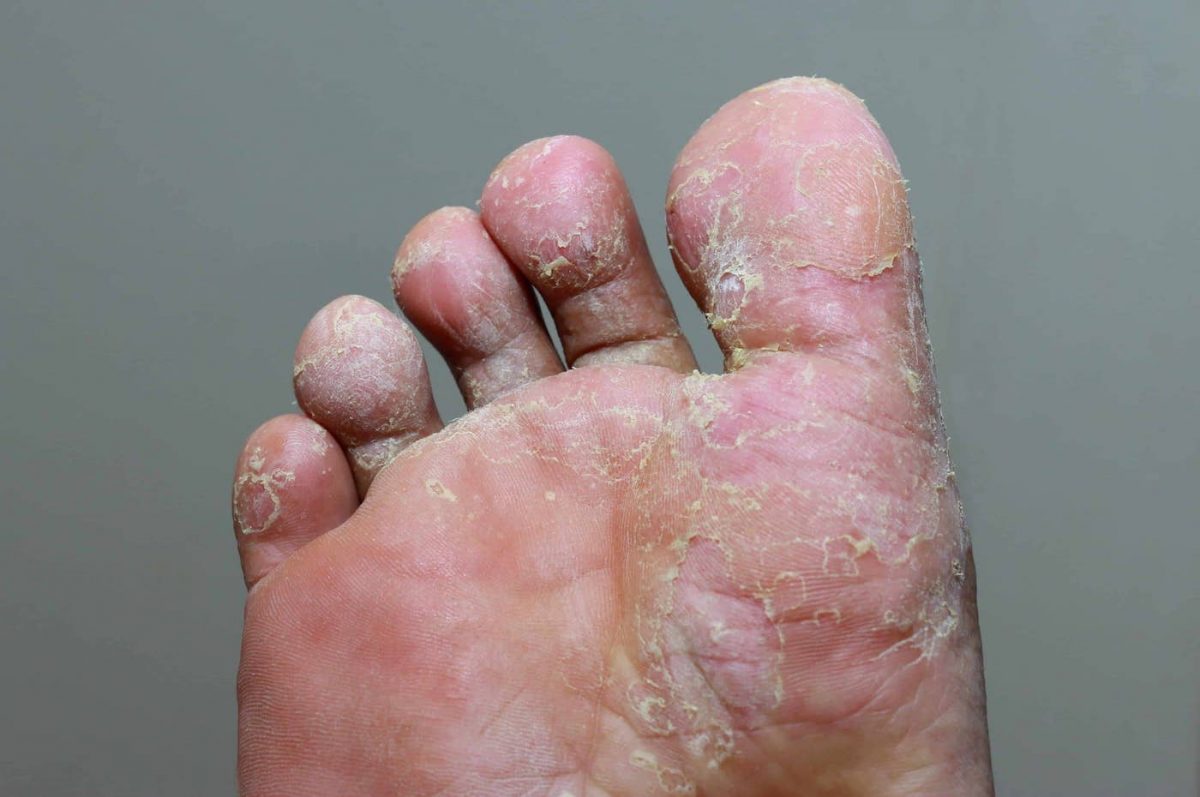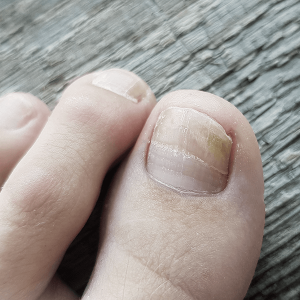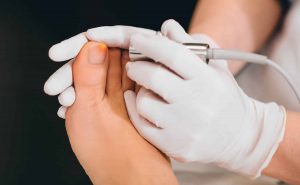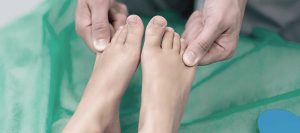
There is a fungus among us was a statement that most probably arose from ads promoting some horror flick of decades past.
Fungal infections, which are also known as mycosis, are conditions that are caused by micro organisms such as: yeast or mold, that invade human tissue and can spread into bones, other organs and, if left untreated, the entire body.
Truth be told, a foot fungus can be a horror tale of its own kind to the bearer of such and often requires some degree of medical intervention by our teams at JAWS Podiatry.
What Exactly Is A Foot Fungus?
A foot fungus is described as a superficial skin infection of the foot that can affect the outer layers of skin, hair and nails.
More than 80 types of fungi are known to thrive on human feet, albeit only a few are harmful. A foot fungus is caused by mold-like bacteria that live in dead cells found on skin, hair and nails.

These fungi adore dark, warm and moist places like the inside of our shoes. Being that each human foot contains more that 250,000 sweat glands, drying one’s feet after they get wet and letting shoes air out before wearing them again are important preventive considerations.
There are several types of foot fungi, which include two broad categories: Athlete’s Foot and Onychomycosis. More on each follows below.
The Dreaded Athlete’s Foot
This fungal skin infection, which is also known as tinea pedis, usually begins between the toes of the foot and often occurs in one to both feet that have become sweaty while confined to poor fitting shoes.

Although not common, it can also affect other parts of the foot. It is the same fungus that causes ringworm and jock itch (tinea cruris).
Experts estimate that 3 to 15% of the population has athletes foot and that 7 out of every 10 people will contract the condition at some point in their life.
Athlete’s foot is a contagious fungus that grows on or in your skin. It requires warm temperatures and moisture to thrive, and if left untreated, is known to spread to other warm, moist parts of the body from the feet to the groin.
Towels and hands provide the perfect vehicles for fungal travel. It can also occur on nails which are more difficult to treat because they are often resistant to medications.
It spreads to the hands when you scratch your infected foot or use the same towel to to dry off feet and hands.
Athlete’s Foot is a burning, itchy, scaly rash that is easily contracted via contaminated public pool areas, gym locker rooms, towels and clothing.
It can be treated with special, anti fungal medications, but just like a criminal perpetrator, it often returns to the scene of the crime.
The usual treatments available include:creams, gels, ointments, powders, and sprays.
Our staff at Jaws Podiatry warns that it is important to finish all the prescription anti-fungals and topical medications as prescribed.
Stopping treatment with these medications too soon can cause the fungus to return and become more difficult to address.
Causes And Symptoms Of Foot Fungus
Athlete’s foot causes a rash on one or both feet. It is located most commonly between the toes, but can also affect other parts of the feet.
Symptoms can include: scaly, peeling or cracked skin between the toes; extreme itchiness, especially after removing shoes and socks; inflamed skin, which can range from reddish to purple to gray, depending on skin color; burning or stinging sensations or blisters.
The Four Types of Athletes Foot Fungus
Several different species of fungi cause athlete’s foot. They are identified by both the location of the rash and its specific appearance. They include: Toe Web; Moccasin; Vesicular; and Ulcerative. More on each follows below.
Moccasin Type
This condition affects the bottom parts of the feet, the edges and the heel. Thickening and cracking of the skin and soreness are usually associated with this condition.
It usually begins with minimal dryness, itching or burning and then worsens into dense, peeling and cracked skin.
Although not common, in extreme cases toenails can become infected, causing them to thicken, crumble and fall out.
Toe Web Type
This infection is the most common of the four, and it is known to occur in the area between the fourth and fifth toes.
Its onset is marked by both a change in the appearance of the skin, which will seem moist and pale white, and some itching and burning in conjunction with a slight odor.
Our staff at JAWS Podiatry advise that left untreated, the skin between the toes grows scaly, peels and splits.
Vesicular Type Infection
The bottom of the feet are affected with this type of infection. It can, however, occur on other parts of the feet as well. Its name derives from the fact that those who suffer from it often develop vesicles, which are fluid-filled blisters. These occur most often on the skin of the instep, but can also appear between the toes, on the heel, sole or top of the foot.
Ulcerative
Very rare and severe, this type of Athlete’s Foot is noted for the painful formation of ulcers or open sores between the toes or on the bottoms of the feet.
Toe Nail Fungus – Also Known As Onychomycosis Fungus
Also known as Toenail Fungus, this condition usually occurs from a crack or cut in a toe. Our teams estimate that this toenail fungus affects 1 in every 10 people, and 1 in every two over the age of 70.
Not only are seniors more susceptible to this often painful condition, it can also affect those who may have damaged nails or circulatory issues in the legs.

This common infection is most likely to attack the big toe, and shows itself in early stages as a white or yellowish brown spot under the tip of a fingernail or toenail.
Discoloration soon follows when the infection progresses, and a nail may become, thick, brittle, change shape and also crumble at the edges. This fungus can also affect several nails.
There are several fungal microorganisms that cause toe nail fungus. The most common is known as a dermatophyte. Others include: yeast, bacteria and molds. More on each follows below.
Dermatophyte
This is the type of mold that causes 90% of toenail infections, which collectively are known as tinea unguium.
Too tiny to discern with the naked eye, they feed upon the protein found in fingernails and toenails known as keratin, which is the substance that makes nails hard.
This type of toe nail fungus is highly contagious and it easily spreads via direct contact or by touching an infected surface.
Yeast
A yeast infection of both the finger and toe nails, which is also called Candida paronychia, this condition attacks the tissue folds surrounding the nail, which become painful, inflamed and swollen.
In severe cases, some pus can also be present. In the worst of instances, the nail can separate revealing a discolored, whitish or yellow nail bed.
This infection is early contracted by skin-to-skin contact with someone who has athlete’s foot or ringworm, or when bare feet come in contact with damp shower floors, swimming pools and locker rooms.
Clinicians often recommend treatments that include: hot water soaks and medications, such as antibiotics or anti-fungals. Pus may need to be professionally drained.
Bacteria
Easy to recognize because it causes a discoloration that tends to be either green or black, bacterial infections of the nails are caused by gram negative bacteria, known as Pseudomonas aeruginosa.
They include erythrasma, abscesses, and cellulitis. Bacteria usually gains ingress to the skin via the cuticle and the skin surrounding the nail.
These infections are usually treated with a seven day round of antibiotics.
Molds
Molds are considered emerging pathogens, and the plant species known as Fusarium Solani is the most common cause of toe nail fungus. The number of cases involving this fungus has increased significantly over the years.
It might appear yellowish, and sometimes a white dot is present on the nail, which grows bigger with time. As the fungus takes hold under the nail, it can loosen and sometimes even separate from the nail bed.
In addition, it is also known to spread to the skin surrounding the nail. Three months of anti-fungal medication can usually cure a toenail fungal infection, although close observance is necessary because there can be side effects.
5 Tips To Prevent Nail Fungus And Reinfections
The following habits can help prevent the development of nail fungus and reinfections.
- Keep Nails Clean And Dry – Wash hands and feet daily using warm, soapy water and rinse and dry thoroughly, especially between the toes. If you have an infected nail, wash again after touching it. Dry well, and just to be on the safe side, apply an anti fungal foot powder.
- Keep Nails Trimmed – Toe nails should be cut straight across and edges should be smoothed down with a file. Disinfect your nail clippers after each use. Longer nails are hotbeds for fungi to grow.
- Choose Shoes That Allow For Breathing Room – Avoid shoes that are tight and closed, and don’t wear rubber or synthetic shoes for long periods of time. Opt instead for sandals that allow your feet to breathe.
- Discard Old Shoes – You can treat them with disinfectant for a while, but old shoes belong in the trash and not on your feet.
- Wear Some Type Of Footwear In Pool Or Locker Rooms – Do not walk barefoot in public swimming pools, saunas, and locker rooms. Wear waterproof sandals.
Contact Our Teams For Any Foot And Nail Fungus Issues
Our cutting edge matrix for ankle and foot care of all types is situated in Hollywood, Florida and headed by our very own, highly-acclaimed Doctor of Podiatric Medicine, Dr Abraham Wagner.

Our patents come from all over the world for our expert care and specialization in functional and cosmetic, surgical procedures and treatments for the foot and ankle.
Our collective of caring professionals offer customized treatment plans for all of our patients and their particular needs.
Our shared focus is always on providing help, the relief of pain and ultimately, a positive, unforgettable foot or ankle treatment experience.
If you are suffering from foot fungus or any other foot or ankle malady, call our teams at JAWS Podiatry today … You and your feet will feel better tomorrow!
- The Life-Changing Power of Cosmetic Foot Surgery - February 27, 2023
- What Are The Most Common Pediatric Foot Conditions? - October 5, 2020
- 4 Important Things To Know Before Having Foot Surgery - September 21, 2020



